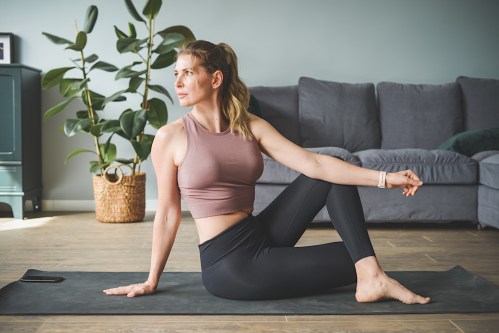‘My Job Is To Help People Stretch Better, and These Are the 5 Mistakes I See Most Often’
Learn to avoid a handful of common stretching mistakes that can lead to injury, including how long and how deep you should be stretching.

Whether you’re releasing all the pent-up neck and shoulder tension from your day or giving your quads and calves some love before a run, there’s just something so delicious about a nice stretch. Not only does stretching feel good, it also helps relieve aches and pains and increases flexibility and mobility. In other words, stretching is a very important part of any fitness routine.
Experts in This Article
vice president of education at StretchLab
physical therapist and co-founder of Body Evolved, a stretching and physical therapy studio in New York City
Like with most things, the key is avoiding common stretching mistakes that prevent you from gaining the full benefit of the stretch, or worse, can seriously hurt your muscles. And, who better to help with this than a professional stretcher? Ahead, learn the top five most common stretching mistakes to avoid, according to Austin Martinez, MS, ATC, CSCS, director of education with StretchLab.
Common stretching mistakes and how to avoid them
What are the most common mistakes people make while stretching? You can probably guess a couple of them, but others are somewhat surprising.
1. You have improper technique
Correct stretching technique is everything. Poor stretching technique can reduce flexibility gains since improper form means you’re not targeting the muscles you want to stretch, which defeats the purpose. “Muscles are oriented and targeted based on the direction the fibers run,” Martinez explains. “Therefore, the angle of your leg/foot or arm could mean you miss out on the benefits.” For instance, if your hip is hiked up too high during a hamstring stretch, that muscle won’t get as big of a release as it would if your hips were aligned properly.
What’s more, whether you’re just doing a few after-work stretches to release an achy back, or some warm-up stretches before your main workout, bad stretching technique could also potentially lead to injury because you could overload the muscle. “Proper technique involves having the right stabilization point and body parts anchored, which creates leverage,” Martinez says. “This results in you getting a deep enough stretch where needed, and ensures that you are safely stretching your body.”
And this is true whether you’re doing dynamic stretching—using active movements like leg swings to open up your range of motion while also getting your blood flowing—or static stretches, in which you hold one position for a given amount of time to encourage a muscle to relax. It pays to be intentional with how you’re moving and placing your body.
How to avoid it: Before you perform any stretch, Martinez recommends doing a little research on safe stretching practices and the muscles you want to target to ensure you know how to do it correctly. Alternatively, he says you can also work with a professional with experience in stretching to offer guidance and tips. Or, you could check out a trainer-approved stretching app so you can follow right along with the pros to avoid stretching errors.
2. You’re stretching too deeply (or not deeply enough)
Another common stretching mistake Martinez often sees has to do with intensity. He emphasizes that stretching should *never* be painful. “It is important to build your tolerance to stretch over time,” he says. “Early on, your body will almost feel like it is resisting the stretch, and tensing up is common. With continued practice, your body’s nervous system will calm down and adapt to the stretch.”
“Early on, your body will almost feel like it is resisting the stretch, and tensing up is common.” —Austin Martinez, CSCS
If you go into too deep of a stretch, you can hurt yourself, in a couple different ways. Overstretching risks include pushing past a muscle’s natural elasticity and also loosening up a muscle so much that you lose control, as physical therapist Corinne Croce, DPT, co-founder of Body Evolved, previously told Well+Good. Remember, although stretching is a legit form of exercise, it’s only one component of a balanced workout regimen that should also include strength training—you want to match that flexibility with strength.
And, on the flip side, if you’re not stretching deeply enough, well, you’re not actually reaping the full benefits of the stretch.
How to avoid it: The key is to pay attention to how your body feels. Martinez notes that common signs of overstretching include holding your breath, squirming, nerve pain, sharp pains in the muscle, or shaking. He suggests imagining an intensity scale ranging from zero (no stretch) to 10 (pain). “For larger muscles, such as hamstrings, quadriceps, and glutes, aim for a five-to-seven stretch,” he says. “For small muscles, such as wrists and neck, aim for a three-to-five stretch. Your aiming point on the scale will start to lower as you progress as your body adapts to stretching.”
3. You’re holding the stretch too long
When it comes to stretching, more isn’t necessarily better. The right timing is essential. The American College of Sports Medicine suggests holding static stretches for just 15 to 30 seconds1. “This duration allows enough time to create adaptations and changes in the muscle,” says Martinez. “After one minute, we see the adaptations/changes are not as pronounced.”
How to avoid it: Make sure you keep track of time. “As you gain mastery, you can use your breath to help you count,” Martinez says. “You’ll even notice that your body instinctively keeps an internal clock, and you’ll have a feeling of when time approaches.”
4. You’re stretching injured muscles
Injuries require ample rest and recovery time. We know this. Still, we’re sometimes tempted to power through it and stretch the injured muscle anyway. Martinez says this is a big mistake. “Injured muscles should not be stretched,” he says. “If you are noticing pain, redness, inflammation, or swelling, please consult a physician or medical professional.”
How to avoid it: Each injury is unique, so how long you should avoid stretching the area will be different, Martinez says. The safest course of action is to talk to a physician and physical therapist who can explain the progression timeline for you specifically.
5. You’re not getting support
While you can definitely get a good stretch in when you’re doing it solo, Martinez recommends working with a pro to really step up the benefits. “Not asking for help could mean you miss out on results with your flexibility, range of motion, or performance,” he says. Working with a coach or instructor also helps keep you accountable and allows you to tap in to their expertise and get personalized stretching recommendations based on your unique needs. Plus, a pro stretcher can also help you get a deeper, yummier stretch while targeting the areas that are hard to reach on your own.
How to avoid it: If your budget allows for it, working with a pro will help you up your stretching game and gain the most benefits from the practice. Or, if you want to go a more budget-friendly route, ensure you do your research and lookup videos led by experts, so you know you’re doing the right stretches in the right way. YouTube is a gold mine of stretching sessions. Feeling tense from slouching at your computer all day? Try an eight-minute head, neck, and shoulder stretch. Need a post-workout full-body stretch or a cool-down stretch after a good run? There’s that too. Just hit play and get your stretch on.
Start to deepen your stretching practice by checking out this quick routine to release upper body tension, below:
Page, Phil. “Current concepts in muscle stretching for exercise and rehabilitation.” International journal of sports physical therapy vol. 7,1 (2012): 109-19.
↩︎










